|

|
|
Video artist and educator, Skip Blumberg
|
|
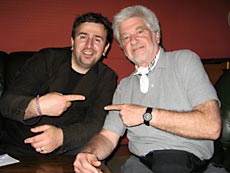
|
|
Skip with Jeton Neziraj, the Kosovo MY HERO /GLOBAL EXCHANGE Site Administrator, at the Cinema Cafe in Prishtina.
|
|
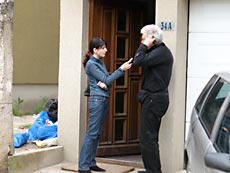
|
|
Skip getting interviewed after a screening of the U.S. EXPRESS outside the Rhizoma Gallery in Prishtina.
|
|
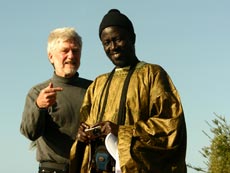
|
|
Skip with Cheikh Check, the Senegal MY HERO /GLOBAL EXCHANGE Site Administrator, in Laguna Beach, California.
|
|
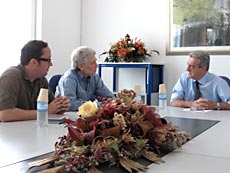
|
|
Skip and Tony meeting the Dean of South Eastern European University.
|
|
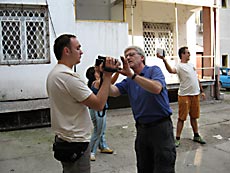
|
|
Doing his camera exercises workshop in Tetovo, Macedonia
|
|

|
|
With U.S. Embassy personnel in Skopje, Macedonia.
|
|

|
|
Skip working with children in Prishtina, Kosovo.
|
|
SKIP BLUMBERG
I taught myself video production in the late 1960s, soon after graduating from college, when consumer video was first introduced. A brand new medium, there were no teachers. This was a lucky accident that allowed me to break new ground for the medium as I advanced my skills. The camera was black and white, connected by a cable to a separate 1/2" reel-to-reel tape recorder (called "porta-pak" ), which together weighed 24 pounds. I immediately enjoyed video production, shooting for several hours every day on the streets of NYC, sometimes just recording soccer games to practice pans and zooms. And art museum curators, seeing my exercises, would say, "aah, deconstructing television!" My career was jump-started with immediate exposure and recognition in the art world and the press; including articles in Newsweek, Rolling Stone Magazine, the New Yorker and ArtForum.
With money saved from a year of teaching grade school, I bought a portapak and became part of a very small community of early users who were ardently exploring what was unique about video. I joined a production group with 9 other friends called Videofreex, sharing equipment and skills. First we had a large studio in NYC's SoHo neighborhood and then we all moved to a 17-room, former rooming house called Maple Tree Farm in the Catskill Mountains of upstate New York. It was an era of foment and change, but, believe me we had lots of fun.
We started one of the first media centers and, with grants from the NYS Council on the Arts and the National Endowment for the Arts, opened our video production and editing studio to visiting mediamakers. One of our educational programs, called Media Bus (there was no actual bus, we had VW minivans) introduced the new medium in workshops at schools, colleges, community centers, libraries and newly-started cable TV access channels. We also operated Lanesville TV, the first pirate low-power TV station, broadcasting our art videos and the first video documentaries including with Yippie Abbie Hoffman, Black Panther Fred Hampton, rock bands, dancers, architects, the first Earth Day environmentalists, and other video artists like Nam June Paik , etc.) as well as local coverage of our rural community.
These early years, filled with adventures and experiments, have informed everything I've done since.
Having fallen in love with the girl next door, (my wife, artist Jane Aaron), I left the group, first working as a TV engineer at San Francisco public TV station KQED, where I learned mainstream production methods, and then as an independent producer. I was fortunate to receive several artist grants including a John Simon Guggenheim Memorial Fellowship and selection as Artist-in Residence at the Lake Placid Winter Olympics and several public TV stations.
I am happiest when I am in production and have produced hundreds of videos including Interviews with Interviewers, Pick Up Your Feet: the Double Dutch Show, Flying Morning Glory (on fire) and many others that have been broadcast around the world, screened in museums and at festivals (including retrospectives at the Berlin and Rotterdam Film Festivals) and which are still in distribution.
The exposure and recognition lead to work-for-hire on many TV series including Zoom, Great Performances,, Matters of Life and Death, and The 90's, on PBS, Inside Space on the Sci-Fi Channel, and National Geographic Journal. Since 1992, I have been a regular segment producer for Sesame Street, producing more than 100 cultural docs and performance video shorts for the series.
Now with more experience (and several awards), I began teaching workshops again, including camcorder-for-TV production and interviewing techniques at the University of Hawaii and the Ohio Arts Council Summer Media Institutes. I was also the keynote speaker at the 1992 Louisiana Media Rendezvous and the 2003 Videomaker Magazine Expo.
My work with MyHero.com began in the earliest years as NYC producer for the original MY HERO TV pilot with stories about FDNY firefighters, author Michael Crichton and his hero scientist George Schaller.
Since then I have worked on the MY HERO Teacher Training DVD, coverage of The 1999 UN Peace and Tolerance Awards including the Post Pessimists of Pristina (Kosova), teacher Susanne Nobles and her Fredericksberg (VA) H.S. students (who is a MY HERO curriculum advisor) , and several hero videos on the website (search my name for 8 short films) and The MY HERO Report. One film, Cookie Girl in the Hot Zone won MY HERO Film Festival awards for me and for Jemma, the Cookie Girl who baked and served cookies to the Twin Towers rescue workers in the days after the tragedy.
A DVD that I produced, Nam June Paik: Lessons from the Video Master, was recently released. A G-rated short version for students received a 2006 MY HERO Film Festival award for best experimental video.
Another video (produced for the New Haven Free Public Library), Building Heroes, which focused on the Library's outreach program that made use of the MY HERO curriculum, won a Gold Plaque at the 42nd Chicago International Film.
In 2005, I curated and produced U.S. EXPRESS,a comprehensive exhibition of art videos sponsored by the U.S. State Department Bureau of Education and Cultural Affairs and distributed throughout the world, which has screened in Kosova, Macedonia, Egypt, Myanmar and several other countries.
This lead to the MY HERO Global Exchange Project (for which I am Artistic Director and a workshop trainer), also with support from the Department of State. The project first brought representatives from six countries to the MY HERO Project's Laguna Beach headquarters to work with MY HERO Project staff. In Spring of 2007, MY HERO webmaster/digital artist Antonio Mendoza and I ventured to four Balkan countries for week-long workshops, training more than 50 local participants to produce videos and other digital art about their heroes.
This work has enabled me to develop a novel camcorder production curriculum that in a short period of time trains even new videomakers to produce high quality videos that can attract and interest their intended audiences.
It's ironic to me that I myself have been called "a hero" for my civic activism as founder and President of Friends of City Hall Park in NYC and specifically for leading the successful battle to re-open our neighborhood park and NY's city commons (closed since 9/11 and a block from the WTC site).
I have really appreciated the support and encouragement for my work by the MY HERO Project. Not only is the MY HERO website in the technical vanguard, the site's dedication to good values and to nurturing our next generation is an important achievement. With powerful commercial electronic media that too often panders to the base desires of its youth audience, MY HERO successfully fulfills a crucial need. I hope to continue to be on the MY HERO staff. I look forward to seeing the results of your participation in this vital network.
|